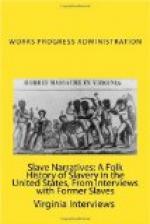“Mrs. Murray’s son gave her five hundred dollars. She hid it. After she died no one knew where to find it.”
Scott Bond bought the place. Bunny was fixing the hearth (she showed us the very spot) brick and found a brick. Dora threw it out. The can could never be found and soon Dora went home near Chattanooga, Tennessee. Dora was a Negro servant in the Bond home. It seems the money was in the old can that Bunny found but thought it was just a prop for the brick.
Maggie (Bunny) Bond has given two of her white friends coffins. One was to a man and two years ago one was to a woman, Mrs. Evans’ daughter. She wanted to do something, the nicest thing she could do for them, for they had been good to her. People who raised them and had owned them. They gratefully accepted her present. In her life she has given beautiful and expensive wedding preaents to her white friends who raised her and owned her. She told us about giving one and someone else said she gave two. Theo Bond’s wife said this about the second one.
The Yankees passed along in front of the Scott Bond home from Hunter, Arkansas to Madison, Arkansas. It was an old military road. The Yankees burnt up Mt. Vernon, Arkansas. Madison was a big town but it overflowed so bad. There were pretty homes at Madison. Levies were not known, so the courthouse was moved to Forrest City. Yankees camped at Madison. A lot of them died there. A cemetery was made in sight of the Scott Bond yard. The markings were white and black letters and the pailings were white with black pointed tips. They were moved to the north. Madison grew to be large because it was on a river.
Interviewer’s Comment
Maggie (Bunny) Bond is eight-ninth white.
Interviewer: Thomas Elmore Lucy
Person interviewed: Caroline Bonds
Russellville,
Arkansas
Age: 70
“What’s all dis info’mation you askin’ about goin’ to be for? Will it help us along any or make times any better? All right, then. My name’s Caroline Bonds. I don’t know jist exactly when I was born, but I think it was on de twentieth of March about—about—yes, in 1866, in Anderson County, North Carolina.
“So you was a ‘Tarheel’ too? Bless my soul!
“My old master was named Hubbard, and dat was my name at first. My parents belonged to Marse Hubbard and worked on his big plantation till dey was freed.
“I was too little to remember much about what happened after de War. My folks moved to Arkansas County, in Arkansas, soon after de War and lived down dere a long time.
“I joined de Missionary Baptis’ Church when I was fifteen and has belonged to it ever’ since.
“No sir, I never got in de habit of votin’ and never did vote, never thought it was necessary.”
Interviewer: Samuel S. Taylor
Person interviewed: Rev. Frank T. Boone
1410
W. Seventeenth Street, Little Rock, Arkansas
Age: 80




